Abstract
Oxygen consumption (VO2) and colonic temperature (Tc) were measured in groups of rats before and after 30% total body surface, full thickness burns. Some wounds were seeded with Pseudomonas aeruginosa or Staphylococcus epidermidis, and some seeded wounds were treated with Sulfamylon or Silvadene. Three groups became bacteremic (B) during the 2-3 week period of observation. At an ambient temperature (Ta) of 32 C, VO2 of the B group rose from 0.83 +/- 0.01 to 1.20 +/- 0.01 ml/hr/g (mean +/- S.E., p less than 0.001) versus 0.81 +/- 0.01 to 0.99 +/- 0.02 for nine nonbacteremic (NB) groups (p less than 0.001). Tc increased only in the B groups--from 36.8 +/- 0.1 to 37.7 +/- 0.1 C (p less than 0.001). In the second or third week postinjury, VO2 of the NB rats was reduced when Ta was increased to 34 C; Tc followed changes in Ta. Sulfamylon lowered VO2 of P. aeruginosa seeded, NB rats. The metabolic cost of wound contamination appeared to vary with bacterial strain. The metabolic effects of infection appear to be a continuum, beginning with a modest rise in VO2 and progressing to greater increases in VO2 and Tc with wound invasion and systemic infection.
Full text
PDF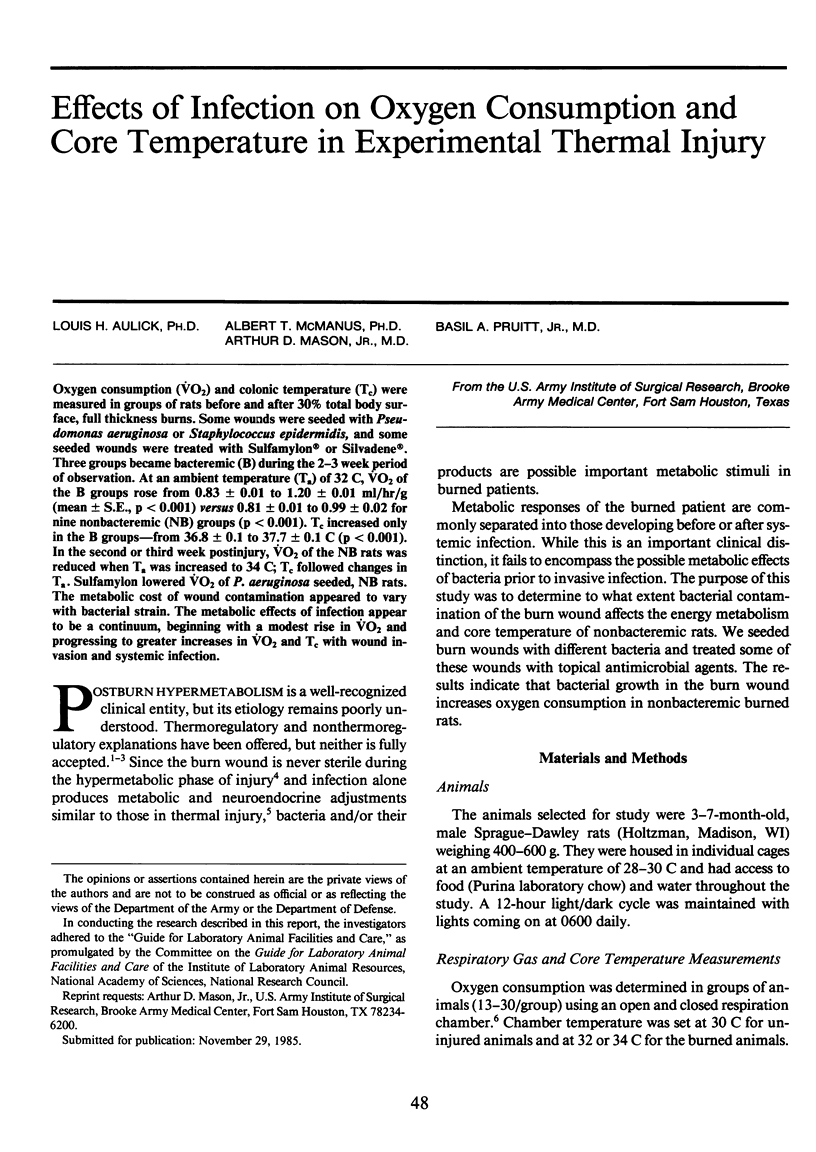
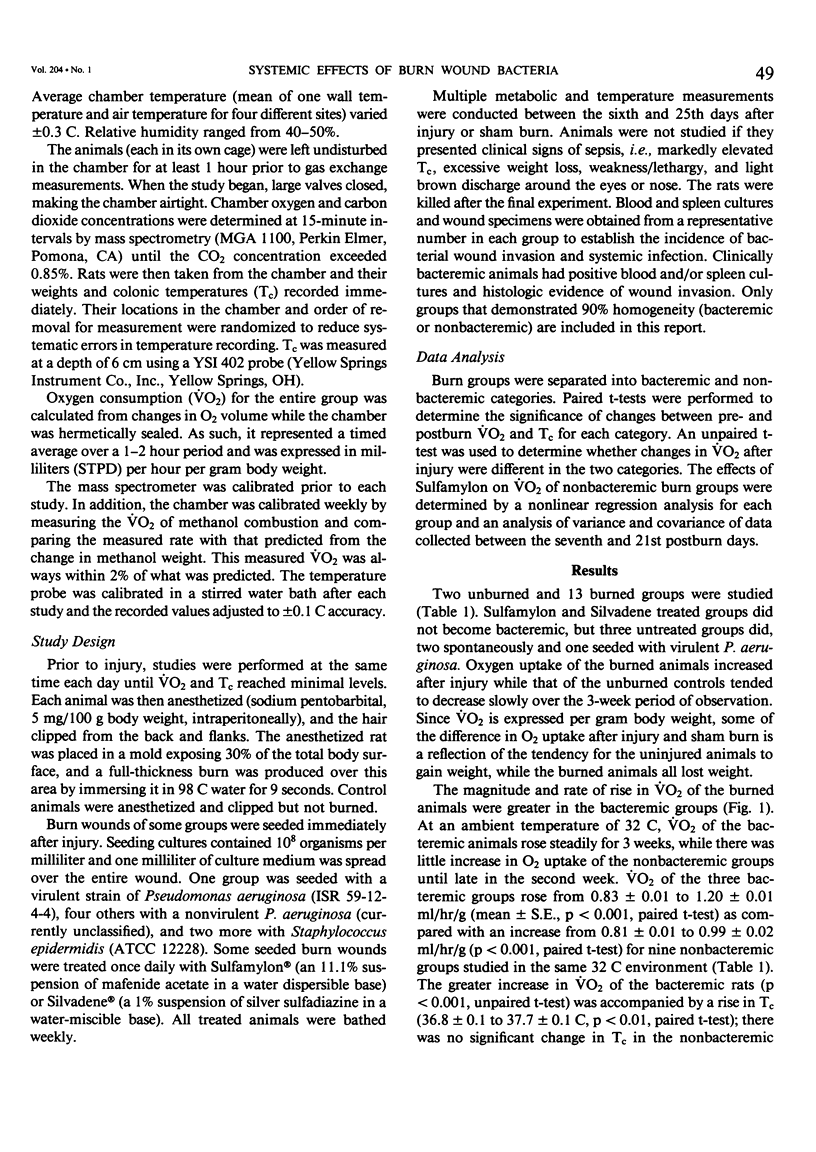
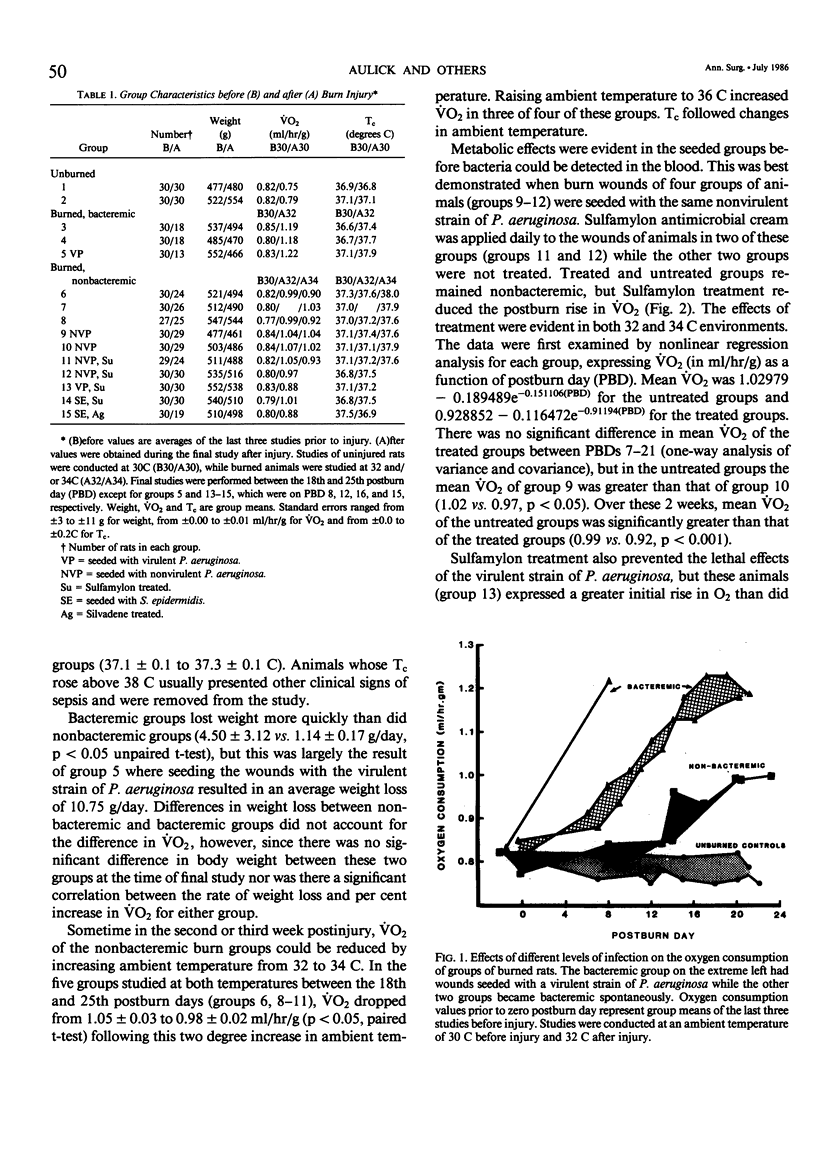
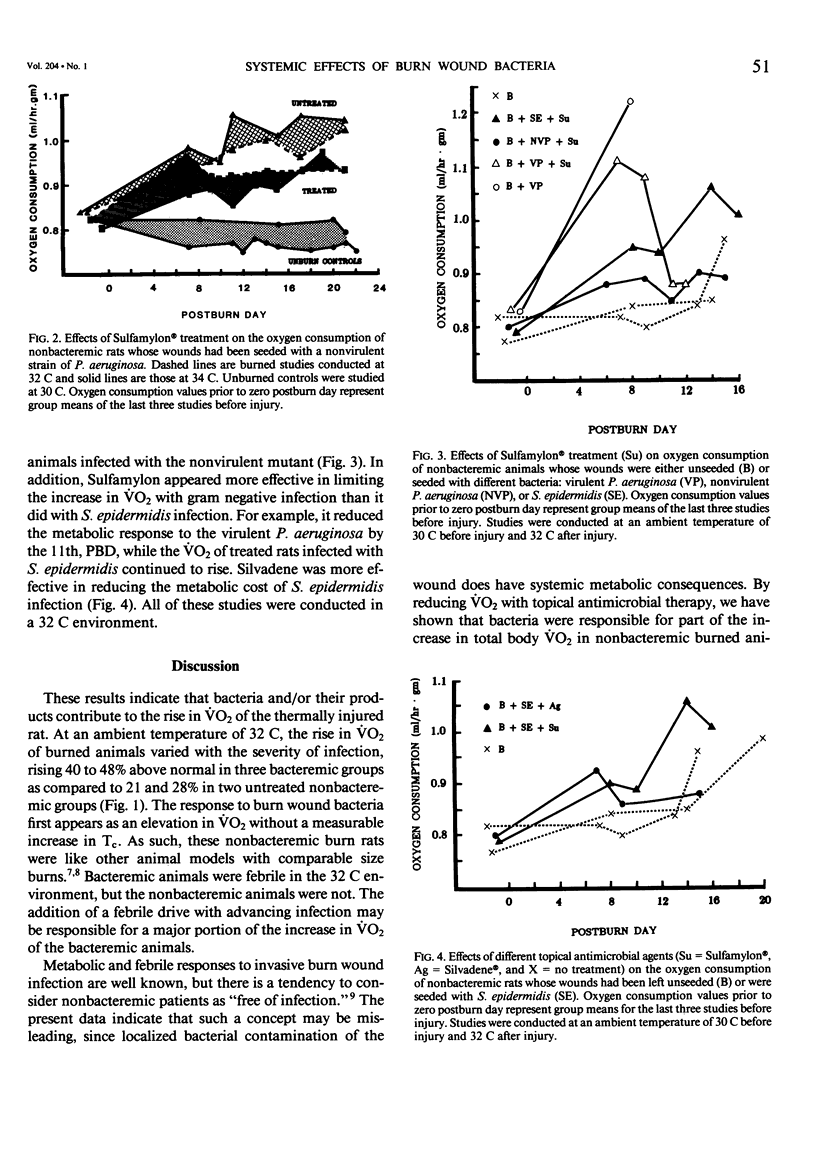
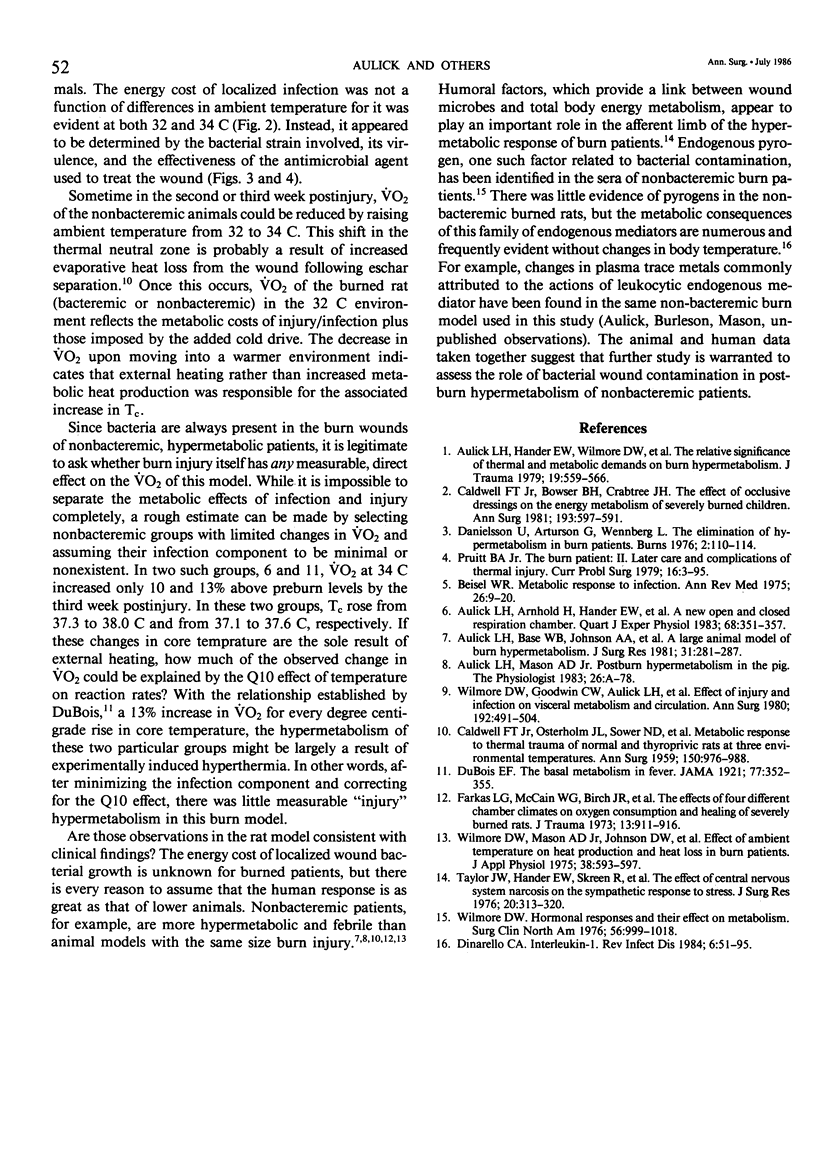
Selected References
These references are in PubMed. This may not be the complete list of references from this article.
- Aulick L. H., Arnhold H., Hander E. H., Mason A. D., Jr A new open and closed respiration chamber. Q J Exp Physiol. 1983 Jul;68(3):351–357. doi: 10.1113/expphysiol.1983.sp002730. [DOI] [PubMed] [Google Scholar]
- Aulick L. H., Baze W. B., Johnson A. A., Wilmore D. W., Mason A. D., Jr A large animal model of burn hypermetabolism. J Surg Res. 1981 Oct;31(4):281–287. doi: 10.1016/0022-4804(81)90050-0. [DOI] [PubMed] [Google Scholar]
- Aulick L. H., Hander E. H., Wilmore D. W., Mason A. D., Jr, Pruitt B. A., Jr The relative significance of thermal and metabolic demands on burn hypermetabolism. J Trauma. 1979 Aug;19(8):559–556. doi: 10.1097/00005373-197908000-00003. [DOI] [PubMed] [Google Scholar]
- Beisel W. R. Metabolic response to infection. Annu Rev Med. 1975;26:9–20. doi: 10.1146/annurev.me.26.020175.000301. [DOI] [PubMed] [Google Scholar]
- CALDWELL F. T., Jr, OSTERHOLM J. L., SOWER N. D., MOYER C. A. Metabolic response to thermal trauma of normal and thyroprivic rats at three environmental temperatures. Ann Surg. 1959 Dec;150:976–988. doi: 10.1097/00000658-195912000-00003. [DOI] [PMC free article] [PubMed] [Google Scholar]
- Caldwell F. T., Jr, Bowser B. H., Crabtree J. H. The effect of occlusive dressings on the energy metabolism of severely burned children. Ann Surg. 1981 May;193(5):579–591. doi: 10.1097/00000658-198105000-00007. [DOI] [PMC free article] [PubMed] [Google Scholar]
- Dinarello C. A. Interleukin-1. Rev Infect Dis. 1984 Jan-Feb;6(1):51–95. doi: 10.1093/clinids/6.1.51. [DOI] [PubMed] [Google Scholar]
- Farkas L. G., McCain W. G., Birch J. R., James J. The effects of four different chamber climates on oxygen consumption and healing of severely burned rats. J Trauma. 1973 Oct;13(10):911–916. [PubMed] [Google Scholar]
- Pruitt B. A., Jr The burn patient: II. Later care and complications of thermal injury. Curr Probl Surg. 1979 May;16(5):1–95. doi: 10.1016/s0011-3840(79)80009-x. [DOI] [PubMed] [Google Scholar]
- Taylor J. W., Hander E. W., Skreen R., Wilmore D. W. The effect of central nervous system narcosis on the sympathetic response to stress. J Surg Res. 1976 Apr;20(4):313–320. doi: 10.1016/0022-4804(76)90019-6. [DOI] [PubMed] [Google Scholar]
- Wilmore D. W., Goodwin C. W., Aulick L. H., Powanda M. C., Mason A. D., Jr, Pruitt B. A., Jr Effect of injury and infection on visceral metabolism and circulation. Ann Surg. 1980;192(4):491–504. doi: 10.1097/00000658-198010000-00008. [DOI] [PMC free article] [PubMed] [Google Scholar]
- Wilmore D. W. Hormonal responses and their effect on metabolism. Surg Clin North Am. 1976 Oct;56(5):999–1018. doi: 10.1016/s0039-6109(16)41029-7. [DOI] [PubMed] [Google Scholar]
- Wilmore D. W., Mason A. D., Jr, Johnson D. W., Pruitt B. A., Jr Effect of ambient temperature on heat production and heat loss in burn patients. J Appl Physiol. 1975 Apr;38(4):593–597. doi: 10.1152/jappl.1975.38.4.593. [DOI] [PubMed] [Google Scholar]


